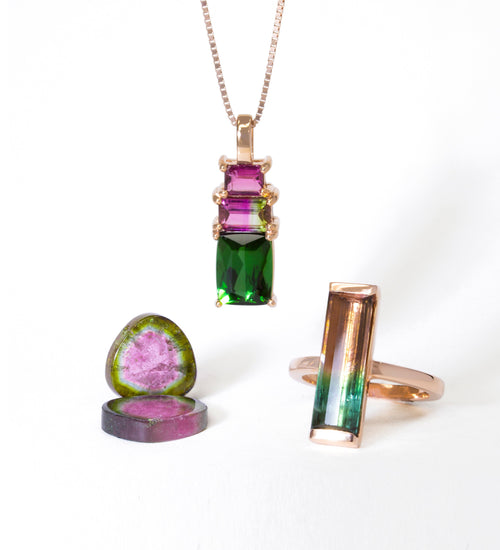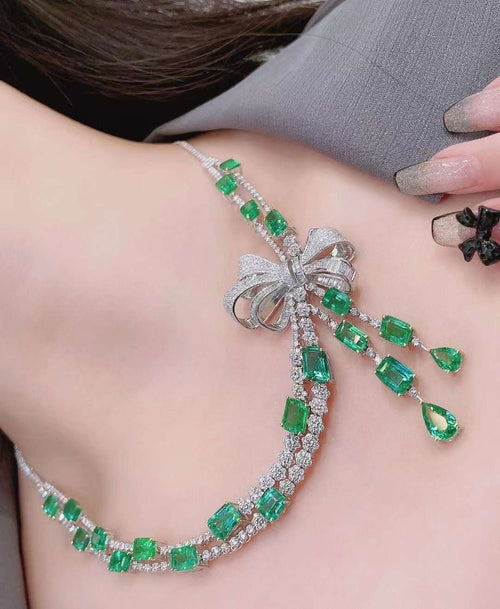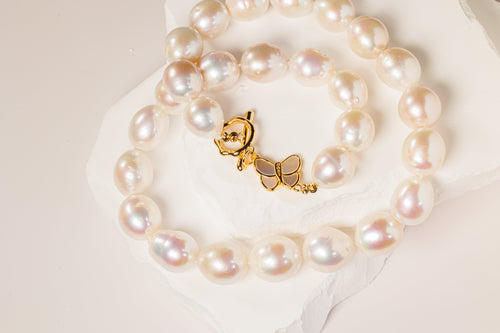Questions about products? Email/call us to schedule a free LIVE session for a custom shopping experience!
Emerald has captivated hearts for centuries with its lush green hues and powerful symbolism of renewal, love, and vitality. Whether adorning ancient royalty or modern collectors, emeralds remain one of the most treasured and iconic gemstones in the world. But what exactly makes emeralds so special—and so valuable? Let’s explore the origins, color, inclusions, treatments, care, and mystique behind this remarkable gem.
Origin: Where Emeralds Are Found
The finest emeralds come from a handful of regions around the world:
-
Colombia: Widely regarded as the source of the world's most beautiful emeralds. Colombian emeralds are prized for their vibrant green color with a slight bluish tint and exceptional clarity.
-
Zambia: Zambian emeralds tend to be a deeper, richer green with slightly cooler undertones. They are often cleaner (fewer inclusions) compared to Colombian stones.
-
Brazil: Produces a wide range of emeralds, from light to dark green, though Brazilian stones can sometimes be less vivid.
-
Afghanistan, Ethiopia, and Pakistan: These countries are emerging as notable sources, offering beautiful, high-quality emeralds with varied color profiles.
Each geographic origin carries its own subtle differences in hue and internal characteristics, contributing to a gem’s uniqueness and value.
Color: The Essence of an Emerald
An emerald’s color is its most important and defining characteristic. True emeralds are a pure green to bluish green.
-
Hue: Should be predominantly green with secondary hues of blue.
-
Tone: Ideally medium to dark; lighter-toned green beryls are classified simply as "green beryl," not emerald.
-
Saturation: The more vivid and intense the green, the more valuable the stone.
The finest emeralds exhibit a deep, velvety color that seems to glow from within—what connoisseurs call “jardín” (Spanish for "garden") because of its lushness.
Inclusions: The "Garden" Inside
Unlike diamonds, where inclusions can detract from value, inclusions are expected and accepted in emeralds.
-
Common inclusions include tiny fractures, gas bubbles, and minute crystals trapped inside the stone.
-
These natural features are often referred to as the emerald’s "jardín," and they add character and authenticity.
-
Eye-clean emeralds (without visible inclusions) are extremely rare—and extremely expensive.
Treatments: Enhancing Natural Beauty
Due to their natural inclusions and fractures, most emeralds undergo treatment to improve their appearance and durability.
-
Oil treatment is the most traditional and accepted method, using natural oils (such as cedarwood oil) to fill surface-reaching fissures and enhance clarity.
-
Resin and polymer fillers may also be used, though these are considered less desirable than natural oil treatment.
-
Treated emeralds should always be disclosed, and untreated emeralds command significant price premiums.
Why Are Emeralds So Expensive?
Several factors drive the high cost of emeralds:
-
Scarcity: Fine quality emeralds are far rarer than diamonds.
-
Natural Flaws: Their formation process leads to more inclusions and fractures, making clean, vivid stones especially rare.
-
Color Demand: The rich green color is highly coveted and culturally symbolic across many civilizations.
-
Mining Difficulty: Extracting emeralds without damaging them is challenging and labor-intensive.
Together, these factors create a perfect storm of rarity, desirability, and high value.
How to Care for Emeralds
Emeralds require gentle care due to their natural inclusions and treatments:
-
Avoid Ultrasonic Cleaners: The vibrations can cause fractures or loosen treatments.
-
Mild Cleaning Only: Use warm, soapy water and a soft cloth or brush.
-
Keep Away from Heat: High temperatures can dry out or alter the appearance of oil-treated stones.
-
Store Separately: Emeralds can scratch easily compared to harder stones like sapphires and diamonds. Store them in a soft pouch or a separate jewelry compartment.
Regular re-oiling by a trusted jeweler can also help maintain the stone’s beauty over time.




